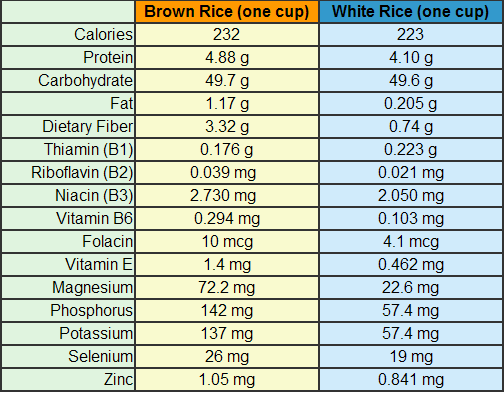Rice is an excellent source of energy. It is comprised of 77.5% carbohydrate; carbohydrate is one of the human body's two main sources of energy, the second being fat. Like other cereals, the carbohydrate in rice is mainly in the form of starch - a complex carbohydrate, and like other cereals the starches occur in granules in the endosperm. Starch exists as either amylose or amylopectin and comprises units of glucose (a simple sugar) linked together in very large numbers. During digestion, the links are broken and the resulting glucose is absorbed into the body. Amylopectin contains branches and is less resistant to digestion whereas amylose is a straight chain molecule and harder for the digestive system to break up. This means that rice varieties with a greater proportion of starch in the form of amylose tend to have a lower glycaemic index (see below for more information on the glycaemic index).

Rice is an excellent food source, low in fat and high in starchy carbohydrate. Rice is packed full of vitamins and minerals and provides an excellent source of vitamin E, B vitamins (thiamin, niacin) and potassium. Brown rice and basmati rice have medium or low GI values, and are not associated with increasing risk factors for weight gain and diabetes. Rice has been found to be very easy to digest. It is low in fat, low in cholesterol, high in starch, and has a high nutritional content. Rice also contains a range of important nutrients, including B and E vitamins, protein, and minerals - especially potassium which helps the body reduce toxins. Rice can contribute significantly to vitamin and mineral intake, although the contribution to micronutrient intake will depend on the proportion of germ, bran and endosperm consumed (i.e. the balance between brown and white rice). According to the UK's Food Standard Agency Balance of Good Health food model, cereal products including rice, alongside potatoes, bread and cereals, should form the major part of a meal. These guidelines recommend that one-third, or 33%, of meals are based on carbohydrate rich food such as rice, bread, pasta and potatoes. In terms of calories, carbohydrate rich foods should make up around 50% of our total calorific intake. Allergic reactions to rice are rare in the western world, and rice can be an invaluable alternative source of carbohydrate and energy for anyone allergic to gluten or wheat. Rice can also be ground and made into flour and wine.